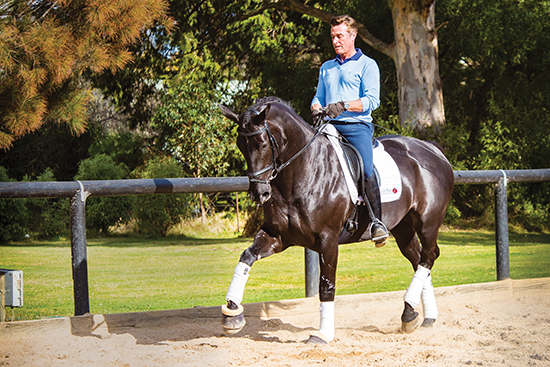 Words and photos by Rebecca Ashton
Words and photos by Rebecca Ashton
Rodney Martin is a quiet achiever. You don’t see him spruiking his wares on social media and he also has a life outside of the horse world, that of a hairdresser. But Rodney is always there in the young horse ring, accumulating ribbons, trophies and titles. Add to that the fact that he trained the auction record-breaking sale horse Dante at the famous PSI Auctions earlier this year and you get the idea that Rodney is no one horse wonder.
Spring was just breaking through a chilly Southern Highlands winter when I caught up with Rodney on the property he shares with dressage-star partner Matthew Dowsley.
So Rodney, how did the whole dressage journey begin?
“I’ve been riding since I was about five. Mum and Dad trained racehorses for a hobby and I used to ride the racehorses a bit and do track work. When their racing career was over, I would try and get them going and then sell them. I was a hacky until I was about 16. I won at Sydney Royal, which is the best show in Australia and I thought, ‘Where do I go from here?’”
“All my horses always went a bit more like dressage horses anyway; you know, I wanted them to go on the bit. I didn’t want to sedate them and if I didn’t sedate them then they needed to be on the aids more. I was one of the more fortunate people because we had a swimming pool for the horses, so all my hacks would go in the swimming pool for half an hour before we went to a show to tire them out! I mean it’s better than sedating them or lunging them for 12 hours!”
“But I was always interested in dressage. I think it came from ignorance a bit. The only people that would come to the Hayshed at Pialligo were Gert Donvig, Clemens Dierks and Christian Thiess. At the time I didn’t know if they were good or not, but they gave me the concept of walk, trot and canter.”
What do you think your secret is to all your young horse success?
“If they go correctly, you can improve the horse’s pace. Sure, you can’t make them move more than they actually can naturally, but you can make a horse that just rickets around do a medium trot without force, just by transitions and going backwards and forwards and working on their balance. That’s what I pride myself on. I’m not a vain person at all, but I think that’s why my young horses go so well because, sure they’re four and I push them, but they’re only ridden four days a week for about 20 minutes, but in that 20 minutes, I want them to go up on the bit and I play with them; I play with each pace. I’ll go rising trot forward and then back and forward so that they learn that it’s all the same no matter what you’re doing. They learn in the end that when they come back, they get to go forward again and they actually quite like it. They bounce together and they think, ‘Oh, I’m going again.’”
“I see the problem so much here with people riding piaffe/passage, people think too much about piaffe. They think passage, then they think trot then they think extended trot, all as separate things. People forget that it’s all just trot. It’s the adjustability of the trot. I want them to go walk, trot and canter, but I start at an early age to go forward and come back.”
“It’s not about teaching a four-year-old how to passage so you can get a better trot because that’s completely incorrect. Also you can’t make any animal do something they can’t physically do. That’s where I think some riders have to learn the limits.”
“But in the end it’s just training. I see horses out there and think that’s a far better horse than the one I’m riding, but it hasn’t been trained correctly. It doesn’t show off what it can do. You see great horses at FEI level and you think if on y they’d put them on the bit, because they’re really nice horses. The amount of times people come up and tell me how lucky I am because I’m given such amazing horses, but it’s the work.”
“Renaissance is a beautiful horse and Dante was a beautiful horse and physically they can do the work, but it was the training. Dante didn’t move like that naturally.”
How do you split the horses between yourself and Matthew?
“Usually I’ll have the young ones. I’ve got a couple also that are a bit smaller. It depends on the horse. Usually once I start riding them, I keep riding them. Before I had all the success, sometimes people were funny when they’d bring a horse here and Matthew would say, ‘I’m not going to be riding it, Rodney’s going to be riding it.’ Now they don’t mind and some people want me to ride the young ones because I’m good with them. But that took a long time before people accepted me riding them.”
Rodney and Matthew with Renaissance
How many would you ride a day?
“I do five maybe six and Matthew does the same. Then we’ve got two boys here and they ride a couple of horses that have just been broken in. I’m old now, I don’t want to fall off! It’s like skiing, you think about falling off your skis now. You see the kids and they go flying by because they don’t think about falling down so then they don’t hurt themselves when they do fall. We try to save ourselves and that’s when we hurt ourselves.”
Do you get bored of just doing baby horse work?
“The young ones are so much fun because they haven’t been interfered with by other people so they’re like a child. If you teach a child properly, then they’re good. Even though I’m tough, I know if they’re tired in the back or if their tail sticks out funny then you think well that’s enough, they’re tired. I don’t push them past that point.”
“The general public somehow think that dressage is light and fluffy. If a horse drops the bit, which some people think is good and they should be so light and there should be no rein, it means that nothing is connected, there is no throughness. It’s got to go from the hindlegs, over the back, through the neck to the bit and if there’s something that’s not connected in that you have no contact, how can it go from the back to the front and into the bridle? And sometimes when you push them they get a bit strong, but then that’s how you develop self carriage; they lighten up and they’ve got to yield to you somewhat. It’s not about pulling their heads in. It’s about a consistent contact and getting it from the back end to the front. To a degree I think they’ve got a job to do. The other 23 hours of the day they get totally spoilt.”
“I think that’s why so many riders have problems when they get to the five and six-year-old classes, they’re still treating them like young horses. I mean I don’t agree particularly how the German industry for young horses is just to make them move for a ten, because then you have nothing afterwards. But at the same time a six-year-old here should be able to do a half pass, should be able to do a flying change, should be collected and if you do it right from a four-year-old, it’s easy. They don’t even think about it, it just happens.”
“I think it’s great that Australians are nicer to their horses, but to wait until the horse comes on the bit, that’s just crap. Horses aren’t that smart. You have to show them the way.”
If you’re looking for a young horse, do you look for a horse for young horse classes or do you aim to take them all the way through?
“Especially in Europe, it’s now two completely different sports. There are professional young horse riders and then there are the FEI riders. Here we should be able to do both and as I said, it’s the training. I’ve had nice horses, but I’ve made them better and that’s why I have had success at DWTS and CDIs because international judges see that even though it’s four, the riders get on and they can touch it with the whip and they can go forward and they can come back and that’s how it should be, not just crossing your fingers and hope you get around the ring, which I do sometimes as well! Haha.”
“But if I was looking for a young horse, long gone are the days of buying the horse with the biggest trot, the biggest canter, the biggest walk. Sure it helps in the four-year-old class but usually horses with great big paces find it really difficult to collect because they’re too slow. I don’t care if it hasn’t got the best trot, but there’s got to be nothing wrong with the trot and the conformation has to be good, the hindleg has to be under and they have to be quick, and sure the walk and canter are the most important.”
“I want a horse that will over track in walk, but not over track a mile because when you take the reins and say collect, then you have problems with a lateral walk. I’d pick a horse that had normal, correct paces because with correct training you will make them better. Over the years, Matthew and I have had some real donkeys, and I don’t hate that horse anymore than any other horse. I don’t like the best horse in the stable more than any other one. My attitude is, ‘Ok, I can make this horse better. It’s here, it’s what I’ve got to work with, let’s see if I can make it better.’ It’s a challenge. I’ve always prided myself on that, developing any horse. And that’s why I like the young ones because unless they’re full of shit or are unsound, you can improve them and each day they get better.”
Temperament. What do you look for there?
“Like the four-year-old I’ve got now, SPH Renaissance, to me she’s perfect. She’s hot but she’s sensible. She wants to do it and I have to be careful because she always wants to do too much but she’s not stupid, she doesn’t shy. And it’s what Anna-Sophie (Fiebelkorn, young horse riding judge) said at the Sydney CDI, that the horse is fabulous. All the others, the five and the six-year-olds were all tired. This four-year-old was the only one that when Anna got on, still wanted to do it, pricked her ears and said, “here I am”. That’s the type of horse I like.”
“Whereas Sonata (SPH Sonata Hit) was a bit more difficult, which everyone knows. He was hot in the same way, but naughty. But I think now that I’ve been overseas so many times and have more knowledge, in hindsight I would have started him differently. I kind of let him get away with things because I didn’t want him to lose that pizzazz he had. He won the four, five and six-year-old classes at DWTS but he never got Champion of Champions because he would come in and spin around. As Ulf Möller said, “You know this horse is going to do this. Don’t let him do it.” Whereas I thought, ‘Oh, it’s alright.’ He never did anything that made me think I was going to fall off. Everyone would look at him and say, “Isn’t he amazing!” so I would think, oh that’s good, he’s mucking up a bit and pat him or do something stupid! But I have lost classes because of that. I would do more now to try and keep that pizzazz, but without him being naughty. He’s never actually done anything wrong in a test, but even to this day I have to lead him up to the arenas at the Nationals, so I think I created that a bit, but that was me not knowing enough.”
“Now with the young ones as soon as I’m on, they’re on the bit and they have to walk up to where we’re going.”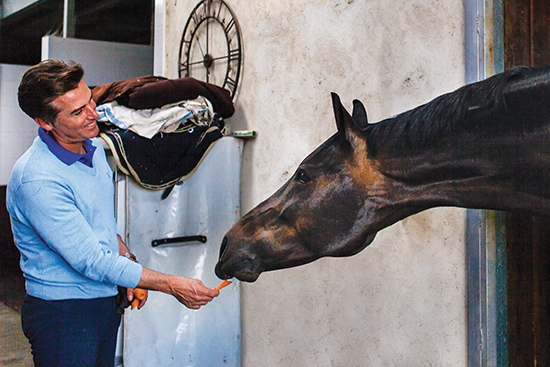
Rodney and Sonata Hit in the stable
You want the pizzazz, but have them sensible, you need that hotness and spark but you need relaxation through their back. How do you go about getting that in terms of your training methods?
“It’s really difficult. As I said with Sonata, I could contain his tenseness, but he would always look a bit tense. The judges would say, “tight in the neck,” or “he looks tense”. That’s just that particular horse. I don’t actually know how to answer that because every horse is different. Dante never looked tense even if he was; Bella (Renaissance) has tension but she just does the job. Maybe I’m better now as a rider, when they’re four I let them do their job and make it fun for them.”
“Human nature is a funny thing, everything we should do with horses is really not natural for humans. If the horse is tense or naughty we tend to take our aids off, if they’re pulling we tend to not push them, if they’re tense we take our legs off whereas it’s actually the opposite you want to be doing. If they’re tense you should put your legs on and push them so that they listen to you and that also creates confidence in the horse. If you have your legs on at home when everything is fine and you go to a show and they get tense and you take your legs off and do the opposite, the horse is wondering where you are.”
“So, forward, back, push them so you get them thinking, lots of transitions and just try to ride them the same as you do at home.”
Do you do a lot of lateral work as well?
“Four year olds, because they’re still growing and their bones are soft, I tend not to. But, they’ve got to be straight so I’m always thinking shoulder fore and like all animals, like us, they’re all one sided. Most horses are stiffer on one side than the other so say a horse is really nice to the left, to the right I’ll think travers and things so that they bend their spine and their neck.”
“I start off by stretching them, pick them up, do a bit, walk, pick them up again, do some canter, let them stretch and then I finish and walk them to the front gate and back.”
You mentioned you’ve done a few trips overseas now…
“Five times to Germany just last year! Also when Matthew had Cinderella we were based there for 18 months. We went for eight or nine months the first year with Ulla Salzgeber and then we came home and then we went back to Jürgen Koschel’s for about six months before the horse died. I’m one of those people who always wants to learn. If you think you’re too good, sometimes you can close your mind off. I believe, whoever I go to, even if I don’t like everything about them, if I can get one thing out of them, it’s been worth it. Jürgen, Ulla, Ulf Möller, all of them have different things to offer, all good things, but getting back to my first statement, the most important thing is throughness. The tricks are easy then.”
“People in Australia are too eager to go up the levels and do the movements. I find a young horse just as fun to ride doing walk, trot and canter say as much as Sonata who is about to go Grand Prix because you’re always doing something; leg yielding, making them supple. I just love doing it, I love playing with the horses, I spoil them a bit too much in the stable, but as long as they work they deserve to be spoilt.”
When do you think you’ll start Sonata Hit in Grand Prix?
“I think in about another six months I’ll try. I can do all the Grand Prix movements now and he does have talent for all the hard stuff, but I’ve never ridden a Grand Prix test in competition and it’s so bloody hard. It’s ok to go and do the half pass tour from the test or the piaffe/passage movements on their own in training, but in the test where it’s movement after movement after movement, it’s all so quick that at the end of it, I’ve sort of lost the horse a bit. We can get through it but I don’t want to just get through, I want it to be flash; I want to show off the work that’s gone into it.”
“Originally I thought about the Rio thing, but Rio is going to be so difficult. They’ve got to leave here so early and the quarantine bringing them home is hard. The horses that do go from here, as Brett (Parbery) said, you’ve actually got to look at being away ten months. That’s a lot for a horse. If it was in Europe I’d say yes, I’d go now and train, but I like horses too much to stress them out like that.”
“Plus I can’t afford to be away for a year. Like everyone else, I have a mortgage. We’ve done it a few times and it also takes a while for your business to build up again after you’ve been away. And with my hairdressing clients, as loyal as they are, they have to get their hair done once a month and then they feel loyalty to the new person and then it’s hard for them to come back to me. So once you’re away and have come back and built your business up again, it’s probably more like 18 months.”
“Every aspect is really difficult and people don’t realise. We’re not fortunate enough to have lots of money. We’ve been really lucky with our clients, like the Oatleys, Claudia Harper, Andrea Beatty that they’ve had the funds to help us along, but if we had to do it on our own with our own horse, it would be really difficult. If we’re not here, we don’t have an income.”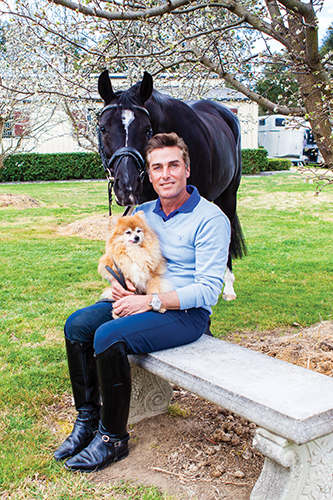
Rodney and Santa Fe with 19-year-old Max: “Santa Fe is a five-year-old owned by Martin Duncan and Karen Michael, and bred by Matthew. San Jose’s first foal out of a Medallion / Donnerhall mare. Won her last few outings at novice / elementary.”
Where do you go when you go to Germany?
“To PSI basically. The first time this year I went to Andy’s (Schöffner) place for a holiday and then we took Dante over and then I went back for the Young Horse World Championships that we didn’t end up doing. Then we went back for the auction. Each time we stayed at PSI they were good because they could see that I liked the young ones so they would give me five or six to ride a day and help me. Just little things like throughness and little tricks they had. Sure, a place like that, people just think it’s all about show, but Bianca Kasselmann is the nicest person. She’s quiet, she does it on her own. I learnt so much about how a horse has to be responsive and do their job without grinding them into the ground. Sometimes I’ll get on a horse and it feels so nice that I’ll get off after 10 minutes because I don’t want to keep going until it’s tired. It’s done everything I’ve asked it to do.”
Is it annoying that you put so much work into a young horse and then it gets sold and you never get to take it right through the levels, or do you just accept it’s part of the business?
“I accept that it’s part of the process, that’s our income. It helps us build our fences, it helps pay the bills. I always say to Matthew though one day, I’m going to keep one horse. One horse and it’s going to be 30 years old which will probably be Sonata because no one will want him! Haha. And Andrea would never sell him which is nice.”
“I think if something happened to Sonata and I didn’t have a Grand Prix horse, I’d be happy with the youngsters. And I always have something at Medium / Advanced. Sure, some of them come here and get sold, but we have 15 here so there’s always something to ride.”
That must have been quite satisfying to have a horse like Dante, that you trained yourself, sell for what it did (the horse sold for 2.8 million euros setting a new PSI auction record)…
“Gee of course! I was thrilled to bits. Sometimes women think men are too strong, but at the auction, I was there watching and so many people rode him, some were so terrible, but he didn’t hang on one rein or the other, they kicked him he cantered, they pulled on the reins he stopped. It’s got nothing to do with strength, it was just correct training. I cried when he was sold, it was terrible at the time.”
Verden still a dream of yours?
“Of course. I mean we just made a bit of a mistake last time. We lost control of the horse. When they said they wanted to buy the horse we should have said yes, but I’m still going to do the championships. The reason I went back the second time was because they dangled the carrot and said there was still a chance but I don’t think there ever was. It’s just a shame because how often do you get to do something like that?”
“In the end he actually got sick at the show. I think that was a travel thing. He got pulled out the morning of the show.”
“Horses break, they get sold, financially it’s hard and I might never get the opportunity again. I would still love to do it, it’s my goal. You look at horses like Sezuan that Dorothee Schneider rides and it’s not a great horse. If you see it standing in the stable, it’s not all that flash, but it’s ridden so beautifully, so soft; shoulder in, circle, half pass, it’s head doesn’t move, it’s so through and supple, it’s so beautiful. So sometimes, sure you can say the young horse riders want these flashy, flashy horses, but at the same time the world champion was a horse that wasn’t that flashy, just ridden and trained so beautifully it had to win. And that’s what I’m about. You don’t have to have the best horse in the world. That’s what dressage is about. And Dorothee is a young horse rider and a Grand Prix rider which is very unusual in Germany.”
“Good, correct riding will prevail in the end.”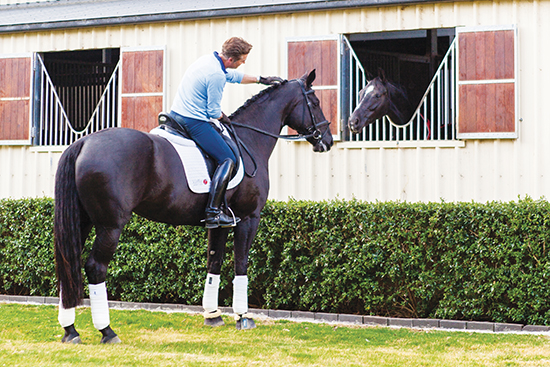
Rodney and Donner Summer talk to Santa Fe in the stable: “Donner Summer is a six-year-old by Don Frederico out of a Weltmeyer mare. She’s really exciting. She has big paces but she’s easy to close up as well. Super temperament, more like a gelding which I prefer. She’s owned by Ann Barber and I’ve been riding her for about six months. I’m thrilled with her. I’m really looking forward to next year with her.”
Do you really think it does though? It hasn’t always gone that way.
“I think things are changing because of the amount of horses you never see again. You see a lot of World Champions but how many do you then see in the FEI ring or at WEG or the Olympics? The owners are happy because they sell them, but I’d like to see both.”
Is there a trainer out there you admire more than any other?
“Jürgen Koshel is very good because it’s not circusy, it’s not heads on the chest, it’s proper riding. I hate the word “classical” but to a degree it is classical. They’ve got to go on the bit, they’ve got to do their job. Good riding gets the horse to move better. To have a lesson off him, it all makes sense. How he says to do something, it works and it’s easy.”
“Ulla was a technician. She was amazing too and I love our national coach Ton (de Ridder). I’ve had lots of lessons with him and he’s along the same lines as Jürgen. If a horse doesn’t want to be round, you make it rounder; if they want to be too round, lift them up. He’s also very good in the way you train with the test in mind. For instance, you’re not allowed to canter in the corner on an FEI horse because it doesn’t happen in the test.”
“You get the basics right and then you train for the test. And that’s probably why he enjoys Matthew and I because he can say, “that’s rubbish, fix it,” and we can because our concept is the same. I’m not saying I’m as good as the Germans but what they want, I understand.”
And what do you get up to when you’re not on a horse?
“Twice a week I go back up to Galston to my hairdressing salon, just in the afternoons so I can still ride in the mornings then I work later and miss the traffic as well.”
“I do the garden here myself. It’s only eight acres and we’ve only been here for four years. The only thing that was here when we came was the house. It was just one, big bushy paddock. We’ve built the stables and the garden and the arena and the fencing is about to be done in two weeks. It takes time… and money! Little things like the driveway needs to be finished and the stables and we’d like an indoor school eventually. It will look lovely in a year or two.”
“We would never go back to Sydney. It’s nicer for the horses here, the climate is better. We die when we have to go to Clarendon or Horsely Park now when it’s hot.”
“I love cooking and I always have people over. I’d prefer to do that than go out. And I drink a lot! It works for me. But I love being here on the property. Moving here was the best thing we ever did. We’ve created some great friends down here too; Brett Parbery and Michelle Baker, Robbie Soster, Dave McKinnon, and all our lovely little group. The restaurants are great and we’re not that far away from the city.”
Wow, you’re really selling it!
“I should be a real estate agent!”
There are lots more articles on dressage and dressage training, just click ‘dressage’ at the top of this page, and you will find a whole library waiting for you…

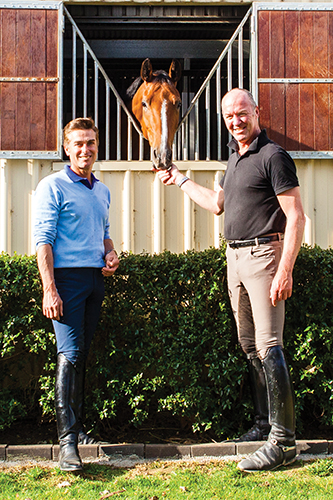
Hi rodney,
read it from the beginning to end ………….. nice story!! Love, Michael
Great story Rodney so happy you are both doing so well, warmest regards Julie Dawes, wife of Ryton, Blacksmith/Farrier/